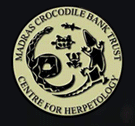Madras Crocodile Bank Trust

Logo of the CrocBank
|
|
| Abbreviation | CrocBank |
|---|---|
| Motto | To promote the conservation of reptiles and amphibians and their habitats through education, scientific research and captive breeding |
| Formation | 1976 |
| Type | NGO |
| Legal status | Non profit public trust |
| Purpose | Herpetofaunal conservation, research and education |
| Headquarters | Chennai |
| Location |
|
|
Region served
|
India |
|
Official language
|
Tamil, English |
|
Founder/director/trustee
|
Romulus Whitaker |
|
Main organ
|
Board of Trustees |
| Affiliations | CZAIUCN/SSC: Snake Specialist Group, Crocodile Specialist group, Tortoise and Freshwater Turtles Specialist Group, Marine Turtle Specialist Group, Indian Subcontinent Reptile & Amphibian Group, Captive Breeding Specialist Group, Sustainable Use of Wild Species Group. |
|
Staff
|
49 |
| Website | www |
Coordinates: 12°44′38″N 80°14′24″E / 12.743875°N 80.240107°E
The Madras Crocodile Bank Trust and Centre for Herpetology (MCBT) is a reptile zoo and herpetology research station, located 40 kilometres (25 mi) south of the city of Chennai, in state of Tamil Nadu, India. The centre is both a registered trust and a recognized zoo under the Wildlife (Protection) Act, 1972 and is India's leading institution for herpeto faunal conservation, research and education. The bank is the first crocodile breeding centre in Asia and comes under the purview of the Central Zoo Authority, Ministry of Environment and Forests, Government of India. It was established with the aim of saving three Indian endangered species of crocodile—the marsh or mugger crocodile, the saltwater crocodile, and the gharial, which at the time of founding of the trust were all nearing extinction.
The CrocBank grounds are covered by coastal dune forest providing a haven for native wildlife, including large breeding colonies of water birds and a secure nesting beach for olive ridley sea turtles. The high aquifer on the sandy coast provides sufficient water supply and the proximity to the major tourist destination of Mahabalipuram ensures annual visitation. The centre is the biggest crocodile sanctuary in India. It covers 8.5 acres (3.4 ha) and had over 450,000 visitors in 2007. The centre has one of the world's largest collections of crocodiles and alligators and has bred 5,000 crocodiles and alligators representing 14 of the 23 existing species, including the three crocodile species, all considered endangered, that are native to India. As of 2011, the CrocBank has a total of 2,483 animals, including 14 species of crocodiles, 10 species of turtles, 3 species of snakes, and 1 species of lizard.
...
Wikipedia
